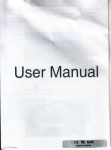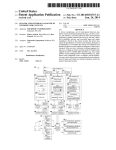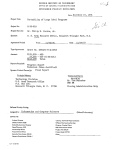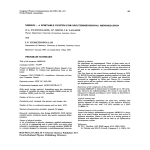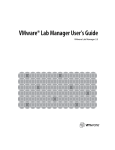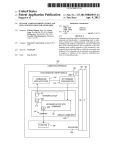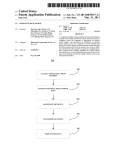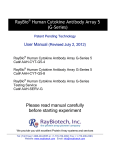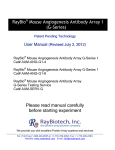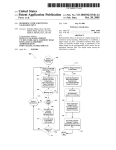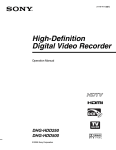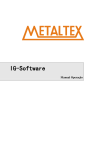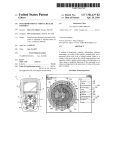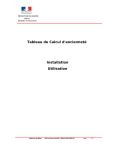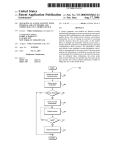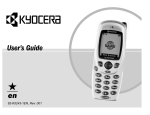Download Physical activity inference from environmental metrics
Transcript
IJ820140167973A1
(19) United States
(12) Patent Application Publication (10) Pub. No.: US 2014/0167973 A1
(43) Pub. Date:
Letchner et al.
(54)
Jun. 19, 2014
(52) U.S.Cl.
PHYSICAL ACTIVITY INFERENCE FROM
ENVIRONMENTAL METRICS
CPC .................................... .. G08C 19/16 (2013.01)
USPC
................................................... ..
340/870.02
(71) Applicant: MICROSOFT CORPORATION,
Redmond, WA (US)
(72)
(57)
Inventors: Julia Maureen Letchner, Seattle, WA
Portable devices include environmental sensors that generate
(US); Scott Saponas, Woodinville, WA
(US); Alice Jane Brush, Bellevue, WA
(US); Aman Kansal, Redmond, WA
(US); Daniel Morris, Bellevue, WA
metrics about the environment (e.g., accelerometers detecting
impulses and vibration, and GPS receivers detecting position
and velocity). Such devices often use environmental metrics
to extract user input directed at the device by the user, and
status information about the device and the environment.
Presented herein are techniques for using environmental met
(Us)
(73) Assignee: Microsoft Corporation, Redmond, WA
(Us)
(21) Appl. No. :
(22)
Filed:
rics to infer physical activities performed by the user while
attached to the device. For example, jogging may be inferred
from regular, strong impulses and typical jogging speed;
13/714,547
walking may be inferred from regular, weak impulses and
typical walking speed; and riding in a vehicle may be inferred
from low-level vibrations and high speed (optionally identi
fying the type of vehicle ridden by the user). Based on these
inferences, the device may automatically present applications
Dec. 14, 2012
Publication Classi?cation
(51)
ABSTRACT
Int. Cl.
G08C 19/16
and/or or adjust user interfaces suitable for the user’s physical
activity, rather than responsive to user input.
(2006.01)
802
COMPUTING DEVICE
[804
[____RROCE§SOR§ET_“
i
806
|
I
1
STORAGE
l
|
PROCESSING
UNIT
:
:
|
812
OUTPUT DEVICE(S)
|
i
I
|
i
I
810
:
I
MEMORY
814
INPUT DEVICE(S)
I
I
I
1
:
l
:
soa
I __________________ __}
fans
COMMUNICATION
CONNECTION(S)
II
V
818
NETWORK
COMPUTING /820
DEVICE
Patent Application Publication
Jun. 19, 2014 Sheet 1 0f 7
US 2014/0167973 A1
100 W
112 R
112 R
MAPPING APPLICATION
112
JOGGING APPLICATION
READING APPLICATION
114 A
114 w
:_—_—_:
114
______ _ _
55555 555555
DISTANCE:
114
55555
4-85 km
116
55555
555555 555—55
116
—“__
i
____
116
I
A
_—_—_—_—_—_
A
PAUSE
STOP
NEXT
BACK MENU
A
A
A
TOUCH
TEXT
TOUCH
TEXT
INPUT
OUTPUT
INPUT
OUTPUT
A
,-118
SPEECH
SPEECH
INPUT
I
118
VISUAL
OUTPUT
108
MODALITY
110
SPEECH
INPUT
102
106
11° 1
ENVIRONMENTAL SENSOR
SPEECH
(GPS RECEIVER)
OUTPUT
103 _\
106
104
‘
MODALITY
ENVIRONMENTAL SENSOR
(ACCELEROMETER)
110 R
TOUCH
INPUT
‘
'
110
VISUAL
OUTPUT
FIG. 1
106 A
ENVIRONMENTAL SENSOR
(MICROPHONE)
Patent Application Publication
Jun. 19, 2014 Sheet 2 0f 7
106
US 2014/0167973 A1
106
ACCELEROMETER
GPS RECEIVER
202 -_
,- 202
j\/—/\/—/\/—/\F
—> —> —> —> —> —>
I 204
206 -\
$
ACTIVITY: JOGGING
102
106
ACCELERQMETER
106
GPS RECEIVER
202 _\
f 202
W
I 204
104
O O O 0 o 0
l
206 -\
ACTIVITY; JOGGING (TREADMILL)
106
106 \
ACCELEROMETER
GPS RECEIVER
r 202
J\/——/\/——/\/—
->
+ —>
~>
~>
~>
I 204
206 R
ACTIVITY: WALKING
102
106
106 -\
ACCELEROMETER
GPS RECEIVER
202 -
m
r 202
104
204
l
206 ~\
{1
ACTIVITY: VEHICLE RIDING
106 -\
102
106 ~\
ACCELEROMETER
GPS RECEIVER
202*
r202
—
104
O O
204
206—\
l
¢
ACTIVITY: SITTING
FIG. 2
O 0 O 0
Patent Application Publication
300
Jun. 19, 2014 Sheet 3 0f 7
x
US 2014/0167973 A1
302
( START y
304
EXECUTE ON PROCESSOR INSTRUCTIONS CONFIGURED TO:
306
RETRIEVE FROM ENVIRONMENTAL SENSORS
ENVIRONMENTAL METRICS
ASSOCIATED WITH DEVICE WHILE ATTACHED TO USER
AND NOT COMPRISING USER INPUT RECEIVED FROM USER
303
IDENTIFY PHYSICAL ACTIVITY THAT,
WHEN PERFORED BY USER WHILE ATTACHED TO DEVICE,
RESULTS IN ENVIRONMENTAL METRIC
310
END
FIG. 3
K~400
402
DEVICE
400 \
408
SYSTEM
412
410
ENVIRONMENTAL
METRIC RECEIVING
COMPONENT
202
+
PHYSICAL ACTIVITY
IDENTIFYING
COMPONENT
200
ENVIRONMENTAL
METR|C
106
I
ENVIRONMENTAL
SENSOR
I
404
i ............ - -1
102 I
202
ENVIRONMENTAL
METRIC
FIG. 4
I
PHYSICAL
ACTIVITY
112
I
APPLICATION
Patent Application Publication
Jun. 19, 2014 Sheet 4 0f 7
US 2014/0167973 A1
500 \
508 N .................. - \x
I
:
I
FF)
:
z
I
I
I
z
i
I
z
1
.
I
I
I
'
I
z
z
t
‘
i
I
I
I
\
‘_
_
_
_
_
_
~
~
_
_
_
_
_
_
_
506
COMPUTER
INSTRUCTIONS
504
01011010001010
10101011010101
101101011100...
_
~
_
_
I
Patent Application Publication
Jun. 19, 2014 Sheet 5 0f 7
US 2014/0167973 A1
600 x
602
START
604
EXECUTE ON PROCESSOR INSTRUCTIONS CONFIGURED TO: K— 606
UPON RECEIVING FROM DEVICE ENVIRONMENTAL METRICS,
NOT COMPRISING USER INPUT RECEIVED FROM USER,
DETECTED BY ENVIRONMENTAL SENSOR OF DEVICE
WHILE ATTACHED TO USER:
[- soa
IDENHPLACCORWNGTOClASSFERLOGKLPHY$CAL
ACTIVITY THAT, WHEN PERFORMED BY USER WHILE ATTACHED
TO DEVICE, RESULT IN ENVIRONMENTAL METRICS
|
/-s1o
SENDPHYSCALACHVHYTT)DEWCE
612
END
626 —\
1r 624
614
PHYSICAL ACTIVITY IDENTIFYING SERVER
SYSTEM
61 8
620
MEMORY
ENVIRONMENT
ENVIRONMENTAL I
I
s
I
SENSOR
I
104
I
I
CD
202
ENVIRONMENTAL
METRIC
206 ~\
PHYSICAL
ACTIVITY
404
102
. MMMMMMMMMMMM
CLASSIFIER
LOGIC
I
I
2
106
622
FIG. 6
PHYSICAL
ACTIVITY
PROFILES
Patent Application Publication
Jun. 19, 2014 Sheet 6 0f 7
US 2014/0167973 A1
206
700
ACTIVITY: DRIVING
[—
|
702
112
112
MAPPING APPLICATION
112
MESSAGE APPLICATION
READING APPLICATION
NEW MESSAGE
FROM JOE
CURRENT TEXT:
TODAY’S NEWS
VOICE
VOICE
COMMANDS:
COMMANDS;
READ NEXT
START MENU
'“ " "1;; T T T T
I?
I : I
206
ACTIVITY: JOGGING
|
702
112
112
MAPPING APPLICATION
114
_
112
MESSAGE APPLICATION
READING APPLICATION
JOE:
CURRENT TEXT:
HOW ARE YOU?
TODAY’S NEWS
_
T'ME- 2036
W
:16 -\
@ i I?
116
116
PAUSE
116
QUICK REPLY ISTART READINGI
116
STOP
116
BACK
116
NEXT
116
I INDEX
MENU}
206
ACTIVITY: STANDING
I
702
112
112
MAPPING APPLICATION
112
MESSAGE APPLICATION
READING APPLICATION
+ I I ADDRESS BOOK I
JOE:3MESSAGES
.
NEW
@
MARK:2MESSAGES
iii—F: :I-{igig
_
_
116
VIEW ROUTEIIMENU] [MORE] [MAIN MENU]
FIG. 7
_
—
—
—
—
—
__
Patent Application Publication
800
Jun. 19, 2014 Sheet 7 0f 7
US 2014/0167973 A1
w
COMPUTING DEVICE
IrnnPF—aOCEésOF—aéETnn1:
l
:
806
|
F810
STORAGE
l
l
PROCESSING
:
UNIT
:l
:
l
|
r8 12
OUTPUT DEVICE(S)
|
:
i
l
:
I
{
:
MEMORY
/—814
INPUT DEVICE(S)
{
i
I
i
:
l
:
808
/—816
COMMUNICATION
CONNECTION(S)
L __________________ __l
818
COMPUTING /‘820
DEVICE
FIG. 8
Jun. 19, 2014
US 2014/0167973 A1
PHYSICAL ACTIVITY INFERENCE FROM
ENVIRONMENTAL METRICS
BACKGROUND
[0001] Within the ?eld of computing, many scenarios
involve devices that are used during a variety of physical
activities. As a ?rst example, a music player may play music
while a user is sitting at a desk, walking on a treadmill, or
jogging outdoors. The environment and physical activity of
the user may not alter the functionality of the device, but it
may be desirable to design the device for adequate perfor
mance for a variety of environments and activities (e. g., head
phones that are both comfortable for daily use and suf?ciently
snug to stay in place during exercise). As a second example,
a mobile device, such as a phone, may be used by a user who
is stationary, walking, or riding in a vehicle. The mobile
computer may store a variety of applications that a user may
wish to utilize in different contexts (e.g., a jogging application
that may track the user’s progress during jogging, and a
reading application that the user may use while seated). To
this end, the mobile device may also feature a set of environ
mental sensors that detect various properties of the environ
ment that are usable by the applications. For example, the
mobile device may include a global positioning system (GPS)
receiver con?gured to detect a geographical position, altitude,
and velocity of the user, and a gyroscope or accelerometer
con?gured to detect a physical orientation of the mobile
device. This environmental data may be made available to
respective applications, which may utilize it to facilitate the
operation of the application.
[0002] Additionally, the user may manipulate the device as
a form of user input. For example, the device may detect
various gestures, such as touching a display of the device,
shaking the device, or performing a gesture in front of a
camera of the device. The device may utilize various environ
selecting and switching among applications to suit the con
text of the user may performed through user input. However,
it may be appreciated that the physical activities of the user
may be determinable automatically according to the environ
mental metrics.
[0005] Presented herein are techniques for con?guring a
device to infer a physical activity of the user, based on the
environmental metrics provided by the environmental sen
sors. For example, the device may include a classi?er utiliz
ing a set of activity pro?les that respectively identify the types
of environmental metrics that are detectable when a user
performs a particular physical activity while the device is
attached to the user. At any point in time (e.g., upon receiving
a request from an application), the device may receive some
environmental metrics from the environmental sensors (ex
clusive of any environmental metrics comprising user input
received from the user), and may invoke the classi?er to infer
the physical activity performed by the user at that time. This
inference may be used to adjust the operation of the device,
e.g., by invoking an application and/or adapting the user
interface of an application in view of the physical activity of
the user.
[0006] To the accomplishment of the foregoing and related
ends, the following description and annexed drawings set
forth certain illustrative aspects and implementations. These
are indicative of but a few of the various ways in which one or
more aspects may be employed. Other aspects, advantages,
and novel features of the disclosure will become apparent
from the following detailed description when considered in
conjunction with the annexed drawings.
DESCRIPTION OF THE DRAWINGS
mental sensors to detect some environmental metrics that
[0007] FIG. 1 is an illustration of an exemplary scenario
featuring a device comprising a set of environmental sensors
and con?gured to execute a set of applications.
[0008] FIG. 2 is an illustration of an exemplary scenario
reveal the actions communicated to the device by the user, and
may extract user input from these environmental metrics.
environmental metrics according to the techniques presented
SUMMARY
method of inferring physical activities of a user based on
environmental metrics.
featuring an inference of a physical activity of a user through
[0009]
[0003]
This Summary is provided to introduce a selection
of concepts in a simpli?ed form that are further described
FIG. 3 is a ?ow chart illustrating an exemplary
[0010] FIG. 4 is a component block diagram illustrating an
exemplary system for inferring physical activities of a user
below in the Detailed Description. This Summary is not
intended to identify key factors or essential features of the
based on environmental metrics.
claimed subject matter, nor is it intended to be used to limit
the scope of the claimed subject matter.
readable medium comprising processor-executable instruc
[0004]
While respective applications of a mobile device
may utilize environmental metrics received from environ
mental sensors in various ways, it may be appreciated that this
environmental information is typically used to indicate the
status of the device (e.g., the geolocation and orientation of
the device may be utilized to render an “augmented reality”
application) and/or the status of the environment (e.g., an
ambient light sensor may detect a local light level in order to
adjust the brightness of the display). However, this informa
tion is not typically utilized to determine the activity of the
user. For example, when the user transitions from walking to
riding in a vehicle, the user may manually switch from a ?rst
application that is suitable for the context of walking (e.g., a
pedestrian mapping application) to a second application that
is suitable for the context of riding (e.g., a driving directions
mapping application). While each application may use envi
ronmental information in the selected context, the task of
[0011]
FIG. 5 is an illustration of an exemplary computer
tions con?gured to embody one or more of the provisions set
forth herein.
[0012] FIG. 6 is an illustration of an exemplary scenario
featuring a physical activity identifying service con?gured to
assist a device in the identi?cation of physical activities of a
user based on environmental metrics.
[0013] FIG. 7 is an illustration of an exemplary scenario
featuring an adaptation of a set of application user interfaces
in view of the physical activity of the user inferred from a set
of environmental metrics.
[0014]
FIG. 8 illustrates an exemplary computing environ
ment wherein one or more of the provisions set forth herein
may be implemented.
DETAILED DESCRIPTION
[0015] The claimed subject matter is now described with
reference to the drawings, wherein like reference numerals
Jun. 19, 2014
US 2014/0167973 A1
are used to refer to like elements throughout. In the following
description, for purposes of explanation, numerous speci?c
details are set forth in order to provide a thorough understand
ing of the claimed subject matter. It may be evident, however,
that the claimed subject matter may be practiced without
these speci?c details. In other instances, structures and
devices are shown in block diagram form in order to facilitate
describing the claimed subject matter.
[0016] A. Introduction
[0017] Within the ?eld of computing, many scenarios
involve a mobile device operated by a user in a variety of
contexts and environments.As a ?rst example, a music player
may be operated by a user during exercise and travel, as well
and visual output presented on the display. In these ways, the
information provided by the environmental sensors 106 may
be used to receive user input 110 from the user 102, and to
output information to the user 102. In some such devices 104,
the environmental sensors 106 may be specialized for user
input 110; e.g., the microphone may be con?gured for par
ticular sensitivity to receive voice input and to distinguish
such voice input from background noise.
[0020] Moreover, respective applications 112 may be
adapted to present user interfaces that interact with the user
102 according to the context in which the application 112 is to
be used. As a ?rst example, the mapping application 112 may
be adapted for use while traveling, such as driving a car or
as while stationary. The music player may be designed to
support use in variable environments, such as providing solid
state storage that is less susceptible to damage through move
ment; a trans?ective display that is visible in both indoor and
outdoor environments; and headphones that are both comfort
riding a bicycle, wherein the user’s attention may be limited
and touch-based user input 110 may be unavailable, but
speech-based user input is suitable. The user interface may
able for daily use and that stay in place during rigorous
exercise. While not altering the functionality of the device
tion of a road and a directional indicator. More detailed infor
therefore present a minimal visual interface with a small set of
large user interface elements 114, such as a simpli?ed depic
mation may be presented as speech output, and the applica
example, a mobile device may offer a variety of applications
tion 112 may communicate with the user 102 through speech
based user input 110 (e.g., voice-activated commands
detected by the microphone), rather than touch-based user
that the user may utilize in different contexts, such as travel
input 110 that may be dangerous while traveling. The appli
oriented applications, exercise-oriented applications, and sta
tionary-use applications. Respective applications may be cus
tomized for a particular context, e.g., by presenting user
cation 112 may even refrain from accepting any touch-based
input in order to discourage distractions. As a second
between environments, these features may promote the use of
the mobile device in a variety of contexts. As a second
example, the jogging application 112 may be adapted for the
interfaces that are well-adapted to the use context.
context of a user 102 with limited visual availability, limited
[0018] FIG. 1 presents an illustration of an exemplary sce
nario 100 featuring a device 104 operated by a user 102 and
usable in different contexts. In this exemplary scenario 100,
the device 104 features a mapping application 112 that is
touch input availability, and no speech input availability.
customized to assist the user 102 while traveling on a road,
controls 116, such as large buttons that may be activated with
such as by automobile or bicycle; a jogging application 112,
which assists the user 102 in tracking the progress of a jog
ging exercise, such as the duration of the jog, the distance
traveled, and the user’s pace; and a reading application 112,
which may present documents to a user 102 that are suitable
for a stationary reading experience. The device 104 may also
Accordingly, the user interface may present a small set of
large user interface elements 114 that may be received
through a brief glance, and a small set of large user interface
low-precision touch input. As a third example, the reading
application 112 may be adapted for a reading environment
based on a visual modality 108 involving high visual input
and precise touch-based user input 110, but reducing audial
interactions that may be distracting in reading environments
such as a classroom or library. Accordingly, the user interface
feature a set of environmental sensors 106, such as a global
for the reading application 112 may interact only through
positioning system (GPS) receiver con?gured to identify a
position, altitude, and velocity of the device 104; an acceler
touch-based user input 110 and textual user interface ele
ometer or gyroscope con?gured to detect a tilt orientation of
ments 114, such as highly detailed renderings of text. In this
manner, respective applications 112 may utilize the environ
the device 104; and a microphone con?gured to receive sound
mental sensors 106 for environment-based context and for
input. Additionally, respective applications 112 may be con
?gured to utilize the information provided by the environ
mental sensors 106. For example, the mapping application
user input 110 received from the user 102, and may present
user interfaces that are well-adapted to the context in which
the application 112 is to be used.
112 may detect the current location of the device in order to
[0021] B. Presented Techniques
display a localized map; the jogging application 112 may
detect the current speed of the device 104 through space in
order to track distance traveled; and the reading application
eral advantageous uses of the environmental sensors 106 to
facilitate the applications 112, and several adaptations of the
112 may use a light level sensor to detect the light level of the
user interface elements 114 and user interface controls 116 of
environment, and to set the brightness of a display component
for comfortable viewing of the displayed text.
respective applications 112 to suit the context in which the
application 112 is likely to be used. In particular, as used in
the exemplary scenario 100 of FIG. 1, the output of the
[0019] Additionally, respective applications 112 may
present different types of user interfaces that are customized
based on the context in which the application 112 is to be
used. Such customization may include the use of the environ
mental sensors 106 to communicate with the user 102 through
a variety of modalities 108. For example, a speech modality
108 may include speech user input 110 received through the
[0022]
The exemplary scenario 100 of FIG. 1 presents sev
environmental sensors 106 is are related to the status of the
device 104 (e.g., its position or orientation), the status of the
environment (e.g., the sound level), or explicit communica
tion with the user 102 (e.g., touch-based or speech-based user
input 110). However, the output of the environmental sensors
106 may also be used as a source of information about the
microphone and speech output produced through a speaker,
status of the user 102 while using the device 104. That is,
while a visual modality 108 may comprise touch user input
110 received through a touch-sensitive display component
while the device 104 is attached to the user 102, the move
ments of the user 102 and environmental changes caused
Jun. 19, 2014
US 2014/0167973 A1
thereby may enable an inference as to the physical activities
performed by the user 102. The functionality of the device
104 may therefore be adjusted to satisfy the physical activity
tions stored in a memory component of the device 104 (e. g.,
a memory circuit, a solid-state storage device, a platter of a
hard disk drive, or a magnetic or optical device) that, When
of the user 102. For example, the device 104 may automati
executed on a processor of the device, cause the device to
cally (i.e., Without prompting from the user 102) present an
application 112 relating to the physical activity, or may adjust
operate according to the techniques presented herein. The
exemplary method 300 begins at 302 and involves executing
the user interface elements 114 and/ or user interface controls
304 the instructions on the processor. Speci?cally, the
instructions may be con?gured to retrieve 306 from at least
116 to suit the physical activity of the user 102. Notably, these
effects are not achieved as responses to user input 1104e.g.,
on data from the environmental sensors 106 from Which user
input 110 directed by the user 102 to the device 104 is
extracted (e.g., an explicit user selection of a “Traveling”
application or mode)ibut, rather, on environmental metrics
from Which the physical activity of the user is inferred.
[0023] FIG. 2 presents an illustration of an exemplary sce
nario 200 featuring a detection of physical activities 206
performed by a user 102 of a device 104 based on environ
mental metrics 202 reported by respective environmental sen
sors 106, including an accelerometer and a global positioning
system (GPS) receiver. As a ?rst example, the user 102 may
perform a jogging physical activity 206 While attached to the
device 104. Even When the user 102 is not interacting With the
device 104, the environmental sensors 106 may detect various
properties of the environment that enable an inference 204 of
this physical activity 206. For example, the accelerometer
may detect environmental metrics 202 indicating a modest
repeating impulse caused by the user’s footsteps While jog
ging, While the GPS receiver also detects a speed that is Within
the typical speed ofjogging physical activities 206. Based on
these environmental metrics 202, the device 104 may there
fore perform an inference 204 of the jogging physical activity
206 of the user 102. As a second example, the user 102 may
perform a jogging exercise on a treadmill. While the acceler
ometer may detect and report the same pattern of modest
repeating impulses, the GPS receiver may indicate that the
user 102 is stationary. The device 104 may therefore perform
an evaluation resulting in an inference 204 of a treadmill
jogging physical activity 206. As a third example, a walking
physical activity 206 may be inferred from a ?rst environ
mental metric 202 of a regular set of impulses having a lower
magnitude than for the jogging physical activity 206 and a
steady but lower-speed direction of travel indicated by the
GPS receiver. As a fourth example, When the user 102 is
seated on a moving vehicle such as a bus, the accelerometer
may detect a latent vibration (e.g., based on road unevenness)
and the GPS receiver may detect high-velocity directional
movement, leading to an inference 204 of a vehicle riding
physical activity 206. As a ?fth example, When the user 102 is
seated and stationary, the accelerometer and GPS receiver
may both indicate very-low-magnitude environmental met
rics 202, and the device 104 may reach an inference 204 of a
stationary physical activity 206. Based on these inferences
204 of the physical activity 206 of the user 102 (not involving
user input 110 from the user 102 that explicitly speci?es the
physical activity 202), the device 104 may present applica
tions 112 and user interfaces particularly well-suited for the
physical activity 206 in accordance With the techniques pre
sented herein.
[0024]
C. Exemplary Embodiments
one environmental sensor 106 at least one environmental
metric 202 that is associated With the device 402 While
attached to the user 102, and Where such environmental met
rics 202 do not comprise user input 110 received from the user
102. The instructions may also be con?gured to identify 308
a physical activity 206 that, When performed by the user 102
While attached to the device 104, results in the at least one
environmental metric 202. The device 104 may then utilize
the inference 204 of the physical activity 206 to many ends;
and by inferring the physical activity 206 based not on user
input 110 but on the evaluation of the environmental metrics
202, the exemplary method 300 operates according to the
techniques presented herein, and so ends at 310.
[0026] FIG. 4 presents a second embodiment of the tech
niques presented herein, illustrated as an exemplary scenario
400 featuring an exemplary system 408 con?gured to identify
physical activities 206 performed by a user 102 of a device
402 comprising at least one environmental sensor 106,
executing at least one application 112, and having an attach
ment 404 to the user 102. The exemplary system 408 may be
implemented, e.g., as a set of processor-executable instruc
tions stored in a memory component of the device 402 (e. g.,
a memory circuit, a solid-state storage device, a platter of a
hard disk drive, or a magnetic or optical device) that, When
executed on a processor 406 of the device 402, cause the
device 402 to operate according to the techniques presented
herein. The exemplary system 408 comprises an environmen
tal metric receiving component 410 that is con?gured to,
While the user 102 is performing a physical activity 206,
receive from respective environmental sensors 106 at least
one environmental metric 202 not comprising user input 110
received from the user 102. The exemplary system 408 also
includes a physical activity identifying component 412 that is
con?gured to, using the environmental metrics 202, identify
the physical activity 206 performed by the user 102, and
report the physical activity 206 of the user 102 to the appli
cation 112. Having achieved the identi?cation of the physical
activity 206 based on an inference from the environmental
metrics 202, the exemplary system 408 causes the device 402
to operate according to the techniques presented herein.
[0027]
Still another embodiment involves a computer-read
able medium comprising processor-executable instructions
con?gured to apply the techniques presented herein. Such
computer-readable media may include, e.g., computer-read
able storage media involving a tangible device, such as a
memory semiconductor (e. g., a semiconductor utiliZing static
random access memory (SRAM), dynamic random access
memory (DRAM), and/or synchronous dynamic random
access memory (SDRAM) technologies), a platter of a hard
disk drive, a ?ash memory device, or a magnetic or optical
disc (such as a CD-R, DVD-R, or ?oppy disc), encoding a set
of computer-readable instructions that, When executed by a
[0025] FIG. 3 presents a ?rst exemplary embodiment of the
techniques presented herein, illustrated as an exemplary
method 300 of identifying a physical activity 206 of a user
102 of a device 104. The exemplary method 300 may be
may also include (as a class of technologies that are distinct
implemented, e.g., as a set of processor-executable instruc
from computer-readable storage media) various types of
processor of a device, cause the device to implement the
techniques presented herein. Such computer-readable media
Jun. 19, 2014
US 2014/0167973 A1
communications media, such as a signal that may be propa
attached to clothing, integrated with clothing (such as shoes,
gated through various physical phenomena (e.g., an electro
vision-correcting glasses, sunglasses, and goggles), and/or
magnetic signal, a sound wave signal, or an optical signal)
and in various wired scenarios (e.g., via an Ethernet or ?ber
optic cable) and/or wireless scenarios (e.g., a wireless local
embedded in the human body.
niques presented herein may be used with many types of
area network (WLAN) such as WiFi, a personal area network
(PAN) such as Bluetooth, or a cellular or radio network), and
environmental sensors 106 providing many types of environ
mental metrics 202 about the environment of the user 102. For
which encodes a set of computer-readable instructions that,
example, the environmental metrics 202 may be generated by
when executed by a processor of a device, cause the device to
implement the techniques presented herein.
[0034]
As a second variation of this ?rst aspect, the tech
one or more environmental sensors 106 selected from an
environmental sensor set comprising a global positioning
[0028] An exemplary computer-readable medium that may
system (GPS) receiver con?gured to generate a geolocation
be devised in these ways is illustrated in FIG. 5, wherein the
metric, a linear velocity metric, and/ or an acceleration metric;
a gyroscope con?gured to generate an angular velocity met
ric; a touch sensor con?gured to detect touch input that does
not comprise user input (e.g., an accidental touching of a
touch-sensitive display, such as the palm of a device who is
holding the device); a wireless communication signal sensor
con?gure to generate a wireless communication signal metric
implementation 500 comprises a computer-readable medium
502 (e.g., a CD-R, DVD-R, or a platter of a hard disk drive),
on which is encoded computer-readable data 504. This com
puter-readable data 504 in turn comprises a set of computer
instructions 506 con?gured to operate according to the prin
ciples set forth herein. In one such embodiment, the proces
sor-executable instructions 506 may be con?gured to perform
(e.g., a cellular signal strength metric, which may be indica
a method of inferring physical activities of a user based on
tive of the distance of the device 104 from a wireless com
munication signal source at a known location); a gyroscope or
environmental metrics, such as the exemplary method #R of
FIG. 3. In another such embodiment, the processor-execut
able instructions 506 may be con?gured to implement a sys
accelerometer con?gured to generate a device orientation
metric (e.g., a tilt impulse, or vibration metric); an optical
tem for inferring physical activities of a user based on envi
sensor, such as a camera, con?gured to generate a light level
ronmental metrics, such as the exemplary system #T of FIG.
4. Some embodiments of this computer-readable medium
puter-readable media may be devised by those of ordinary
metric; a microphone con?gured to generate a sound level
metric; a magnetometer con?gured to detect a magnetic ?eld
metric; and an impedance sensor con?gured to detect mois
ture contacting the device 104. Moreover, a combination of
such environmental sensors 106 may enable a set of overlap
ping and/or discrete environmental metrics 202 that provide a
more robust indication of the physical activity 206 of the user
skill in the art that are con?gured to operate in accordance
102.
may comprise a nontransitory computer-readable storage
medium (e.g., a hard disk drive, an optical disc, or a ?ash
memory device) that is con?gured to store processor-execut
able instructions con?gured in this manner. Many such com
with the techniques presented herein.
[0029]
[0030]
[0035]
As a third variation of this ?rst aspect, the tech
D. Variations
The techniques discussed herein may be devised
niques presented herein may enable the inference 204 of
with variations in many aspects, and some variations may
example, a walking physical activity 206 may be inferred
present additional advantages and/or reduce disadvantages
with respect to other variations of these and other techniques.
Moreover, some variations may be implemented in combina
tion, and some combinations may feature additional advan
tages and/or reduced disadvantages through synergistic coop
eration. The variations may be incorporated in various
embodiments (e. g., the exemplary method 300 of FIG. 3 and
the exemplary system 408 of FIG. 4) to confer individual
and/ or synergistic advantages upon such embodiments.
[0031] D1. Scenarios
[0032] A ?rst aspect that may vary among embodiments of
these techniques relates to the scenarios wherein such tech
many types of physical activities 206 of the user 102.As a ?rst
from a regular set of impulses of a medium magnitude and/or
a speed of approximately four kilometers per hour. As a
second example, a jogging physical activity 206 may be
inferred from a faster and higher-magnitude set of impulses
and/or a speed of approximately six kilometers per hour. As a
third example, a standing physical activity 206 may be
inferred from a zero velocity, neutral impulse readings from
an accelerometer, a vertical tilt orientation of the device 104,
and optionally a dark reading from a light sensor indicating
the presence of the device in a hip pocket, while a sitting
physical activity 206 may provide similar environmental met
[0033] As a ?rst variation of this ?rst aspect, the techniques
presented herein may be used with many types of devices 1 04,
rics 202 but may be distinguished by a horizontal tilt orien
tation of the device 104. As a fourth example, a swimming
physical activity may be inferred from an impedance metric
indicating the immersion of the device 104 in water. As a ?fth
including mobile phones, tablets, personal information man
example, a bicycling physical activity 206 may be inferred
ager (PIM) devices, portable media players, portable game
consoles, and palmtop or wrist-top devices. Additionally,
from a regular circular tilt motion indicating a stroke of an
appendage to which the device 104 is attached and a speed
these techniques may be implemented by a ?rst device that is
exceeding typical jogging speeds. As a sixth example, a
vehicle riding physical activity 206 may be inferred from a
background vibration (e. g., created by uneven road surfaces)
and a high speed. Moreover, in some such examples, the
device 104 may further infer, along with a vehicle riding
physical activity, at least one vehicle type that, when the
niques may be applied.
in communication with a second device that is attached to the
user 102 and comprises the environmental sensors 106. The
?rst device may comprise, e.g., a physical activity identifying
server, which may evaluate the environmental metrics 202
provided by the ?rst device, arrive at an inference 204 of a
physical activity 206, and inform the ?rst device of the
inferred physical activity 206. The device 104 may also have
many types of attachment 404 to the user 102, such as being
carried by the user 102, stowed in a pocket or bag, worn,
vehicle riding physical activity is performed by the user 102
while attached to the device and while the user 102 is riding in
a vehicle of the vehicle type, results in the environmental
metric 202. For example, the velocity, rate of acceleration,
Jun. 19, 2014
US 2014/0167973 A1
and magnitude of vibration may distinguish when the user
102 is riding on a bus, in a car, or on a motorcycle. These and
other types of physical activities 206 may be inferred in
accordance with the techniques presented herein.
[0036] D2. Activity Inference
[0037] A second aspect that may vary among embodiments
of these techniques relates to the manner of reaching an
inference 204 of a physical activity 206 from one or more
environmental metrics 202.
[0038] As a ?rst variation of this second aspect, the activity
inference may be achieved using many types of classi?er
logic. As a ?rst example of this ?rst variation, the inference
204 may utilize one or more physical activity pro?les that are
con?gured to correlate environmental metrics 202 with
physical activities 206, and that may be invoked to select a
physical activity pro?le matching the environmental metrics
202 in order to infer a physical activity 206. As a ?rst example
of this ?rst variation, the classi?er logic may comprise a set of
one or more physical activity pro?les that respectively indi
selecting a physical activity 206, identify a selection con?
dence of the selection of the physical activity 206 associated
with the environmental metrics 202. For example, the device
104 may de?ne an acceptable con?dence level threshold in
selecting one physical activity 206 over other physical activi
ties 206 (e.g., 90% con?dence in an accurate inference 204),
and may only report the inferred physical activity 206 if the
selection con?dence exceeds the acceptable con?dence level
threshold. Additionally, if the selection con?dence is low, the
device 104 may collect at least one additional environmental
metric 202 from the environmental sensors 106 (e.g., continu
ing to sample the environment of the user 102 and the device
104), and may apply the classi?er logic to the combination of
the set of additional environmental metrics 202 and the initial
set of environmental metrics 202 in order to achieve an
acceptably accurate inference 204.
[0041] As a third example of this second variation, the
device 104 may interact with the user 102 to determine the
physical activity 206 represented by a set of environmental
pro?les may be generated by a user 102, automatically gen
metrics 202. For example, ? the environmental metrics 202
are dif?cult to correlate with any currently identi?ed physical
activity 206, or if the user 102 performs a currently identi?ed
physical activity 206 in a peculiar oruser-speci?c manner that
leads to di?icult-to-infer environmental metrics 202, the
erated by one or more statistical correlation techniques, and/
or a combination thereof, such as user manual tuning of
of a “mechanical Turk” solution), to identify the physical
automatically generated physical activity pro?les. The device
activity 206 resulting in the reported environmental metrics
104 may then infer a physical activity 206 by comparing a set
of collected environmental metrics 202 with those of the
activity 206, the device 104 may adjust the classi?er logic in
cate a value or range of an environmental metric 202 that may
enable an inference 204 of a physical activity 206 (e.g., a
speci?ed range of accelerometer impulses and speed indicat
ing a jogging physical activity 206). The physical activity
physical activity pro?les in order to identify a selected physi
cal activity pro?le. As a second example of this ?rst variation,
the classi?er logic may comprise an ad hoc classi?cation
technique, e. g., an arti?cial neural network or a Bayesian
statistical classi?er. For example, the device 104 may com
prise a training data set that identi?es sets of environmental
metrics 202 as well as the physical activity 206 resulting in
such environmental metrics 202. The classi?er logic may be
trained using the training data set until it is capable of recog
niZing such physical activities 206 with an acceptable accu
racy.
[0039]
As a second variation of this second aspect, the
accuracy of the inference 204 of the physical activity 206 may
be sharpened through many techniques. As a ?rst example of
this second variation, respective physical activities 206 may
be associated with respective environmental metrics 202
according to an environmental metric signi?cance, indicating
the signi?cance of the environmental metric to the inference
204 of the physical activity 206. For example, a device 104
may comprise an accelerometer and a GPS receiver. A vehicle
riding physical activity 206 may place higher signi?cance on
the speed detected by the GPS receiver than the accelerometer
(e. g., if the user device 104 is moving faster than speeds
achievable by an unassisted human, the vehicle riding physi
cal activity 206 may be automatically selected). On the other
hand, a speci?c set of highly distinctive impulses may be
indicative of a jogging physical activity 206 at a variety of
speeds, and thus may place high signi?cance on the environ
mental metrics 202 generated by the accelerometer than those
generated by the GPS receiver. The inference 204 performed
by the classi?er logic may accordingly weigh the environ
mental metrics 202 according to the environmental metric
signi?cances for respective physical activities 206.
[0040] As a second example of this second variation, the
classi?er logic may be further con?gured to, in addition to
device 104 may ask the user 102, or a third user (e.g., as part
202. Upon receiving a user identi?cation of the physical
order to achieve a more accurate identi?cation of the physical
activity 206 of the user 102 upon next encountering similar
environmental metrics 202.
[0042] As a third variation of this second aspect, the infer
ence 204 may be performed using many architectures. As a
?rst such example, the device 104 performing the inference
204 may be attached to the environmental sensors 106, or may
be in wireless communication with environmental sensors
106 attached to the user 102. As a second such example, the
inference 204 may be performed by a ?rst device that is in
communication with a second device associated with the
environmental sensors 106, such as a computer of the user
102 or a physical activity identifying service provided over a
network such as the internet. For example, a device 104 may
send the environmental metrics 202 to the service, which may
evaluate the environmental metrics 202, perform an inference
of a physical activity 206, and send the physical activity 206
back to the device. Alternatively, the physical activity identi
fying service may provide a classi?er logic to the device,
which may apply the classi?er logic to perform the inference
204. In either scenario, the second device or physical activity
identifying service may adjust the classi?er logic (e.g., upon
receiving environmental metrics 202 associated with a new
physical activity 206, the device 104 and/or physical activity
identifying service may adjust the inference 204 in order to
infer the physical activity 206 accurately for these environ
mental metrics 202 in the future).
[0043]
FIG. 6 presents an illustration of an exemplary sce
nario 600 featuring several of the variations of the techniques
described herein. In this exemplary scenario 600, a physical
activity identifying server 614 is provided and con?gured to
identify physical activities 206 from environmental metrics
202 reported by various devices 104. For example, while a
user 102 performs a physical activity 206, a device 104 having
an attachment 404 to the user 102 may apply an environmen
Jun. 19, 2014
US 2014/0167973 A1
tal sensor 106 to generate one or more environmental metrics
206. For example, when a driving physical activity 206 is
202, which the device 104 may send to the physical activity
detected, the applications 112 may present a user interface
mode 702 comprising a constrained set of data that is highly
identifying server 614 (e.g., via a wireless communication
link to the intemet). The physical activity identifying server
614 may comprise a processor 406 and a system 616 includ
ing a memory 618, a classi?er logic 620, and a set ofphysical
relevant to driving, which may be presented in a large font,
and may communicate with the user 102 primarily through
speech-based output and speech-based user input. When a
activity pro?les 622. The memory 618 may also comprise
instructions executable by the processor 406, and upon
receiving the environmental metrics 202, may perform 624
the exemplary method beginning at 604 by executing 604 the
jogging physical activity 206 is selected, the applications 112
instructions 626 on the processor 406. In particular, the
instructions stored in the memory 618 may cause the physical
speech-based output and touch-based user input 110 even if
such user input 110 is not highly accurate. As a third example,
activity identifying server 614 to identify, according to the
classi?er logic 620, a physical activity 206 that, when per
when the device 104 detects a standing physical activity 206,
formed by the user 102 while having an attachment 404 to the
device 104, result in the environmental metric 202. The clas
si?er logic 620 may achieve this identi?cation, e. g., by com
702 comprising highly detailed user interface elements 114
(e.g., highly detailed maps) and plentiful user interface con
trols 116 that the user 102 may be able to invoke precisely
while standing. In this manner, the applications 112 may
paring the environmental metrics 202 with those speci?ed in
may present a second user interface mode 702, comprising
information relevant to the user 102 while jogging, and large
user interface controls 116 that the user 102 may select via
the applications 112 may present a third user interface mode
respective physical activity pro?les 622, and, optionally, may
utilize variable user interface modes 702 to present informa
adjust its physical activity pro?les 622 in view of the infer
tion relevant to the physical activity 206 of the user 102,
and/or to communicate with the user 102 through input/out
put modalities that are suitable for the physical activity 206.
[0049] As a third variation of this third aspect, the device
104 may interact with the applications 112 and environmental
ence for this environmental metric 202. The physical activity
identifying server 614 may then send 61 0 the physical activity
206 to the device 104, which may adjust its operation to suit
the physical activity 206 of the user 102. In this manner, the
device 104 and the physical activity identifying server 614
may interoperate to achieve the inference of the physical
activity 206 from the environmental metric 202. Many varia
tions of this exemplary scenario 600 and other such scenarios
may be devised by those of ordinary skill in the art while
implementing the techniques presented herein.
[0044]
D3. Uses of Physical Activity Inference
[0045] A third aspect that may vary among embodiments of
these techniques relates to the con?guration of the device 104
to apply the inferred physical activity 206 of the user 102.
[0046] As a ?rst variation of this third aspect, the device
104 may, upon identifying a newly initiated physical activity
206, identify an application 112 associated with the physical
activity 206, and invoke the application 112. For example,
upon identifying a jogging physical activity 206, the device
104 may identify and invoke an application 112 that is
capable of tracking a jogging exercise and presenting jog
ging-related information to the user 102. Alternatively or
additionally, the application 112 may identify and notify a
currently executing application 112 of a newly initiated
physical activity 206. For example, the device 104 may
receive from an application 112 a request to receive reports of
a particular physical activity 206 (e.g., a driving application
sensors 106 in a manner that conserves the power of the
device 104, particularly for portable devices 104 having lim
ited power supplied by a battery or limited amount of fuel,
and/or constrained computational resources. For example,
the device 104 may typically keep the environmental sensors
106 powered off until receiving from a request from an appli
cation 112 to identify the current physical activity 206 of the
user 102. Upon receiving such a request, the device 104 may
enable the at least one environmental sensor 106, detect the
environmental metrics 202, and, after reporting an inferred
physical activity 206 of the user 102, disable the at least one
environmental sensor 106. In this manner, the device 104 may
achieve the inference 204 of the physical activity 206 while
also conserving power and/or computational resources.
These and other techniques may be applied to utilize the
physical activity 206 inferred by the device 104 in accordance
with the techniques presented herein.
[0050] E. Computing Environment
[0051] FIG. 8 and the following discussion provide a brief,
general description of a suitable computing environment to
implement embodiments of one or more of the provisions set
forth herein. The operating environment of FIG. 8 is only one
example of a suitable operating environment and is not
112 may subscribe to a driving physical activity 206, and may
intended to suggest any limitation as to the scope of use or
provide a callback that the device 104 may invoke upon
functionality of the operating environment. Example comput
detecting a driving physical activity 206). The device 104
ing devices include, but are not limited to, personal comput
may therefore store the request, and, upon identifying the
ers, server computers, hand-held or laptop devices, mobile
requested physical activity 206, may report the physical activ
devices (such as mobile phones, Personal Digital Assistants
ity 206 to the application 112 associated with the request.
(PDAs), media players, and the like), multiprocessor systems,
[0047] As a second variation of this third aspect, one or
more applications 112 may present a ?exible user interface
consumer electronics, mini computers, mainframe comput
ers, distributed computing environments that include any of
the above systems or devices, and the like.
[0052] Although not required, embodiments are described
in the general context of “computer readable instructions”
being executed by one or more computing devices. Computer
readable instructions may be distributed via computer read
that may adapt to the physical activity 206 of the user 102. For
example, an application 112 may comprise at least two user
interface modes, each associated with a different physical
activity 206, and the device 104 may select the user interface
mode for the user interface of the application 112 that is
associated with a current physical activity 206.
[0048]
FIG. 7 presents an illustration of an exemplary sce
nario 700 featuring a set of applications 112 having adjustable
user interface modes 702 for respective physical activities
able media (discussed below). Computer readable instruc
tions may be implemented as program modules, such as func
tions, objects, Application Programming Interfaces (APIs),
data structures, and the like, that perform particular tasks or
Jun. 19, 2014
US 2014/0167973 A1
implement particular abstract data types. Typically, the func
included in device 802. Input device(s) 814 and output device
tionality of the computer readable instructions may be com
(s) 812 may be connected to device 802 via a wired connec
tion, wireless connection, or any combination thereof. In one
embodiment, an input device or an output device from
bined or distributed as desired in various environments.
[0053] FIG. 8 illustrates an example of a system 800 com
prising a computing device 802 con?gured to implement one
or more embodiments provided herein. In one con?guration,
computing device 802 includes at least one processing unit
806 and memory 808. Depending on the exact con?guration
and type of computing device, memory 808 may be volatile
another computing device may be used as input device(s) 814
or output device(s) 812 for computing device 802.
[0059] Components of computing device 802 may be con
(such as RAM, for example), non-volatile (such as ROM,
nected by various interconnects, such as a bus. Such intercon
nects may include a Peripheral Component Interconnect
(PCI), such as PCI Express, a Universal Serial Bus (USB),
?ash memory, etc., for example) or some combination of the
two, such as the processor set 804 illustrated in FIG. 8.
?rewire (IEEE 1394), an optical bus structure, and the like. In
another embodiment, components of computing device 802
[0054] In other embodiments, device 802 may include
additional features and/or functionality. For example, device
802 may also include additional storage (e. g., removable
and/or non-removable) including, but not limited to, mag
netic storage, optical storage, and the like. Such additional
may be interconnected by a network. For example, memory
located in different physical locations interconnected by a
network.
[0060] Those skilled in the art will realize that storage
storage is illustrated in FIG. 8 by storage 810. In one embodi
ment, computer readable instructions to implement one or
more embodiments provided herein may be in storage 810.
devices utilized to store computer readable instructions may
be distributed across a network. For example, a computing
device 820 accessible via network 818 may store computer
Storage 810 may also store other computer readable instruc
tions to implement an operating system, an application pro
gram, and the like. Computer readable instructions may be
readable instructions to implement one or more embodiments
loaded in memory 808 for execution by processing unit 806,
readable instructions for execution. Alternatively, computing
for example.
device 802 may download pieces of the computer readable
808 may be comprised of multiple physical memory units
provided herein. Computing device 802 may access comput
ing device 820 and download a part or all of the computer
The term “computer readable media” as used herein
instructions, as needed, or some instructions may be executed
includes computer storage media. Computer storage media
at computing device 802 and some at computing device 820.
includes volatile and nonvolatile, removable and non-remov
[0061] F. Usage of Terms
[0062] Although the subject matter has been described in
language speci?c to structural features and/or methodologi
[0055]
able media implemented in any method or technology for
storage of information such as computer readable instructions
or other data. Memory 808 and storage 810 are examples of
computer storage media. Computer storage media includes,
but is not limited to, RAM, ROM, EEPROM, ?ash memory or
other memory technology, CD-ROM, Digital Versatile Disks
(DVDs) or other optical storage, magnetic cassettes, mag
netic tape, magnetic disk storage or other magnetic storage
devices, or any other medium which can be used to store the
desired information and which can be accessed by device
cal acts, it is to be understood that the subject matter de?ned
in the appended claims is not necessarily limited to the spe
ci?c features or acts described above. Rather, the speci?c
features and acts described above are disclosed as example
forms of implementing the claims.
[0063] As used in this application, the terms “component,”
“module,” “system”, “interface”, and the like are generally
802. Any such computer storage media may be part of device
intended to refer to a computer-related entity, either hard
ware, a combination of hardware and software, software, or
802.
[0056] Device 802 may also include communication con
nection(s) 816 that allows device 802 to communicate with
is not limited to being, a process running on a processor, a
processor, an object, an executable, a thread of execution, a
other devices. Communication connection(s) 816 may
include, but is not limited to, a modem, a Network Interface
Card (NIC), an integrated network interface, a radio fre
software in execution. For example, a component may be, but
program, and/or a computer. By way of illustration, both an
application running on a controller and the controller can be
a component. One or more components may reside within a
quency transmitter/receiver, an infrared port, a USB connec
process and/or thread of execution and a component may be
tion, or other interfaces for connecting computing device 802
to other computing devices. Communication connection(s)
localized on one computer and/or distributed between two or
more computers.
816 may include a wired connection or a wireless connection.
[0064]
Communication connection(s) 816 may transmit and/or
receive communication media.
[0057] The term “computer readable media” may include
communication media. Communication media typically
implemented as a method, apparatus, or article of manufac
embodies computer readable instructions or other data in a
“modulated data signal” such as a carrier wave or other trans
port mechanism and includes any information delivery
media. The term “modulated data signal” may include a sig
nal that has one or more of its characteristics set or changed in
such a manner as to encode information in the signal.
[0058]
Device 802 may include input device(s) 814 such as
Furthermore, the claimed subject matter may be
ture using standard programming and/or engineering tech
niques to produce software, ?rmware, hardware, or any com
bination thereof to control a computer to implement the
disclosed subj ect matter. The term “article of manufacture” as
used herein is intended to encompass a computer program
accessible from any computer-readable device, carrier, or
media. Of course, those skilled in the art will recognize many
modi?cations may be made to this con?guration without
departing from the scope or spirit of the claimed subject
matter.
keyboard, mouse, pen, voice input device, touch input device,
[0065]
infrared cameras, video input devices, and/ or any other input
herein. In one embodiment, one or more of the operations
Various operations of embodiments are provided
device. Output device(s) 812 such as one or more displays,
described may constitute computer readable instructions
speakers, printers, and/or any other output device may also be
stored on one or more computer readable media, which if
Jun. 19, 2014
US 2014/0167973 A1
executed by a computing device, will cause the computing
device to perform the operations described. The order in
a geolocation metric;
a linear velocity metric;
which some or all of the operations are described should not
an angular velocity metric;
be construed as to imply that these operations are necessarily
an acceleration metric;
a device orientation metric;
order dependent. Alternative ordering will be appreciated by
one skilled in the art having the bene?t of this description.
Further, it will be understood that not all operations are nec
essarily present in each embodiment provided herein.
[0066] Moreover, the word “exemplary” is used herein to
mean serving as an example, instance, or illustration. Any
aspect or design described herein as “exemplary” is not nec
essarily to be construed as advantageous over other aspects or
designs. Rather, use of the word exemplary is intended to
present concepts in a concrete fashion. As used in this appli
cation, the term “or” is intended to mean an inclusive “or”
rather than an exclusive “or”. That is, unless speci?ed other
wise, or clear from context, “X employs A or B” is intended to
mean any of the natural inclusive permutations. That is, if X
employsA; X employs B; orX employs bothA and B, then “X
employs A or B” is satis?ed under any of the foregoing
instances. In addition, the articles “a” and “an” as used in this
application and the appended claims may generally be con
strued to mean “one or more” unless speci?ed otherwise or
clear from context to be directed to a singular form.
[0067]
Also, although the disclosure has been shown and
a light level metric;
a sound level metric;
a magnetic ?eld metric;
a wireless communication signal metric; and
a touch metric that does not comprise user input.
3. The method of claim 1, the at least one physical activity
selected from a physical activity set comprising:
a walking physical activity;
a standing physical activity;
a sitting physical activity;
a jogging physical activity;
a swimming physical activity; and
a bicycling physical activity.
4. The method of claim 1:
the at least one physical activity selected from a physical
activity set comprising a vehicle riding physical activity;
and
the instructions further con?gured to, upon identifying the
vehicle riding physical activity, identify at least one
vehicle type that, when the vehicle riding physical activ
ity is performed by the user while attached to the device
described with respect to one or more implementations,
and while the user is riding in a vehicle of the vehicle
equivalent alterations and modi?cations will occur to others
skilled in the art based upon a reading and understanding of
type, results in the environmental metric.
this speci?cation and the annexed drawings. The disclosure
includes all such modi?cations and alterations and is limited
only by the scope of the following claims. In particular regard
5. The method of claim 1, identifying the physical activity
comprising:
sending the at least one environmental metric to a physical
activity identi?cation service; and
to the various functions performed by the above described
components (e.g., elements, resources, etc.), the terms used to
receive from the physical activity identi?cation service an
describe such components are intended to correspond, unless
user according to the environmental metrics.
6. The method of claim 1:
otherwise indicated, to any component which performs the
speci?ed function of the described component (e.g., that is
functionally equivalent), even though not structurally equiva
lent to the disclosed structure which performs the function in
the herein illustrated exemplary implementations of the dis
closure. In addition, while a particular feature of the disclo
sure may have been disclosed with respect to only one of
several implementations, such feature may be combined with
one or more other features of the other implementations as
may be desired and advantageous for any given or particular
application. Furthermore, to the extent that the terms
“includes”, “having”, “has”, “with”, or variants thereof are
used in either the detailed description or the claims, such
terms are intended to be inclusive in a manner similar to the
term “comprising.”
What is claimed is:
1. A method of identifying a physical activity of a user of a
device having a processor and at least one environmental
sensor, the method comprising:
executing on the processor instructions con?gured to:
retrieve from at least one environmental sensor at least
one environmental metric associated with the device
while attached to the user and not comprising user
input received from the user; and
identify a physical activity that, when performed by the
identi?cation of the physical activity performed by the
the device comprising at least one physical activity pro?le
associated with a physical activity and specifying at least
one environmental metric detected by the at least one
sensor of the device while the physical activity is per
formed by the user while attached to the device, results
in the environmental metric; and
the identifying comprising:
comparing the at least one environmental metric to the
environmental metrics associated with respective
physical activity pro?les to identify a selected physi
cal activity pro?le; and
identifying the physical activity associated with the
selected physical activity pro?le.
7. The method of claim 1:
the device comprising at least two environmental sensors;
respective physical activity pro?les identifying, for respec
tive environmental sensors, an environmental metric
signi?cance indicating a signi?cance of environmental
metrics of the sensor to identifying the physical activity
of the physical activity pro?le; and
the device comprising a classi?er con?gured to identify
physical activities according to the environmental met
rics and the environmental metric signi?cance indica
tors of the physical activity pro?le.
8. A computer-readable storage device comprising instruc
user while attached to the device, results in the at least
tions con?gured to, when executed on a processor of a device
one environmental metric.
executing at least one application and having at least one
environmental sensor and attached to a user, identify physical
2. The method of claim 1, the environmental metric
selected from an environmental metric set comprising:
activities performed by the user by:
Jun. 19, 2014
US 2014/0167973 A1
While the user is performing a physical activity, receive
from respective environmental sensors at least one envi
ronmental metric not comprising user input received
from the user;
using the environmental metrics, identify the physical
activity performed by the user; and
report the physical activity of the user to the application.
9. The computer-readable storage device of claim 8, the
instructions further con?gured to:
receive from at least one application a request to receive
reports of physical activity, store the request; and
upon identifying a physical activity that is associated With
a request, report the physical activity to the application
associated With the request.
10. The computer-readable storage device of claim 8:
15. The computer-readable storage device of claim 12:
the classi?er logic further con?gured to, in addition to the
selection of the physical activity, identify a selection
con?dence of the selection of the physical activity asso
ciated With the environmental metric; and
identifying the at least one physical activity comprising:
invoking the classi?er logic to identify the physical
activity associated With the at least one environmental
metric and having a selection con?dence above a selec
tion con?dence threshold.
16. The computer-readable storage device of claim 15, the
instructions further con?gured to, upon the classi?er logic
failing to identify a physical activity having a selection con
?dence above the selection con?dence threshold:
the device comprising at least one user interface presented
receive at least one additional environmental metric from
the at least one environmental sensor metric; and
to the user having at least two user interface modes
invoke the classi?er logic to identify the physical activity
respectively associated With a physical activity; and
the instructions further con?gured to, upon identifying a
physical activity While presenting the user interface to
associated With the at least one environmental metric
and the at least one additional environmental metric.
the user, select the user interface mode for the user
interface that is associated With the physical activity.
11. The computer-readable storage device of claim 8, the
instructions further con?gured to:
upon receiving from the application a request to identify
the physical activity of the user, enable the at least one
environmental sensor to detect the environmental met
ric; and
after reporting the physical activity of the user, disable the
at least one environmental sensor.
12. The computer-readable storage device of claim 8:
the device comprising a classi?er logic that is con?gured
to, for at least one environmental metric, select a physi
cal activity associated With the environmental metric;
and
identifying the at least one physical activity comprising:
invoking the classi?er logic to identify the physical
activity associated With the at least one environmental
metric.
13. The computer-readable storage device of claim 12:
the device comprising at least one training data set identi
fying, for respective environmental metrics, a physical
activity identi?able by at least one environmental met
ric;
the instructions further con?gured to train the classi?er
logic to identify, for respective training data sets, the
physical activity identi?ed by the training data set for the
environmental metric.
14. The computer-readable storage device of claim 12:
respective environmental metrics identifying the physical
activity When performed by a particular user While
attached to the device; and
the instructions further con?gured to, upon identifying
from the environmental metric the physical activity per
formed by the particular user, update the classi?er logic
to identify the physical activities of the particular user
for the environmental metric.
17. The computer-readable storage device of claim 12, the
instructions further con?gured to, upon receiving from the
user a user identi?cation of a physical activity performed by
the user When the environmental sensor received the environ
mental metric, update the classi?er logic to identify the physi
cal activity of the user for the environmental metric.
18. The computer-readable storage device of claim 17, the
instructions further con?gured to:
receive the classi?er logic from a physical activity identi
fying service; and
upon receiving the user identi?cation of the physical activ
ity, send the user identi?cation and the at least one envi
ronmental metric to the physical activity identifying ser
vice.
19.A method of facilitating devices comprising at least one
environmental sensor in identifying physical activities per
formed by a user While attached to the device, the method
involving a computer having a processor and a classi?er logic
and comprising:
executing on the processor instructions con?gured to, upon
receiving from a device at least one environmental met
ric not comprising user input received from the user and
detected by at least one environmental sensor of the
device While attached to the user:
identify, according to the classi?er logic, a physical
activity that, When performed by the user While
attached to the device, results in the at least one envi
ronmental metric; and
send the physical activity to the device.
20. The method of claim 19, the instructions further con
?gured to, upon receiving from a device an identi?cation of a
physical activity performed by a user While attached to the
device When the environmental sensor detected the at least
one environmental metric, update the classi?er logic accord
ing to the physical activity and the at least one environmental
metric.

















